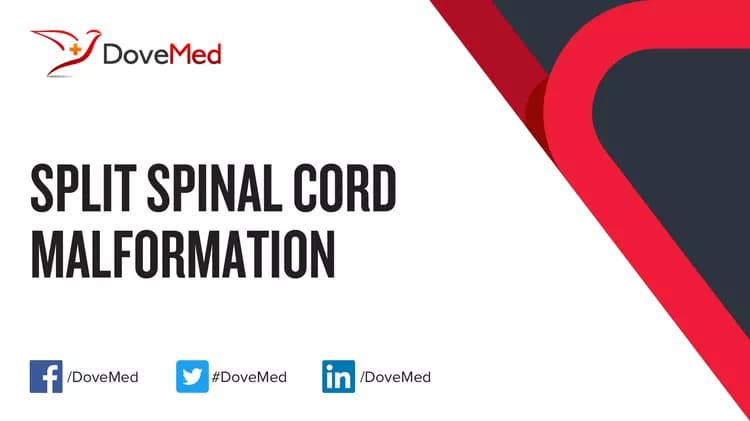What are the other Names for this Condition? (Also known as/Synonyms)
- Diastematomyelia
- Diplomyelia
- Pseudodiplomyelia
What is Split Spinal Cord Malformation? (Definition/Background Information)
- Split Spinal Cord Malformation(SSCM) is a rare form of spinal dysraphism in which a person is born with splitting, or duplication, of the spinal cord
- It may be characterized by complete or incomplete division of the spinal cord, resulting in two 'hemicords'. There are two types of SSCM:
- In type I, each hemicord has a full protective covering (thecal sac) and they are separated by a bony structure, forming a double spinal canal
- In type II, the two hemicords are surrounded by one thecal sac and there is a single spinal canal
- While SSCM is present from birth, it may become apparent at any age and is more common in women than in men
- SSCM is thought to be caused by abnormal formation of the notochord and neural tube (which ultimately form the brain and spinal cord) very early in embryonic development
- Some people may not have symptoms, while others may have a tethered cord and/or various other spinal abnormalities
- Symptoms vary and may include back pain, bladder dysfunction, and leg pain or weakness
- Treatment may include surgery for release of a tethered cord, and/or physical therapy for neurologic problems or pain
(Source: Split Spinal Cord Malformation; Genetic and Rare Diseases Information Center (GARD) of National Center for Advancing Translational Sciences (NCATS), USA.)
Who gets Split Spinal Cord Malformation? (Age and Sex Distribution)
- Split Spinal Cord Malformation is a rare congenital disorder
- While SSCM is present from birth, it may become apparent at any age and is more common in women than in men
(Source: Split Spinal Cord Malformation; Genetic and Rare Diseases Information Center (GARD) of National Center for Advancing Translational Sciences (NCATS), USA.)
What are the Risk Factors for Split Spinal Cord Malformation? (Predisposing Factors)
- A positive family history may be an important risk factor, since Split Spinal Cord Malformation can be inherited
- Currently, no other risk factors have been clearly identified for SSCM
It is important to note that having a risk factor does not mean that one will get the condition. A risk factor increases one’s chances of getting a condition compared to an individual without the risk factors. Some risk factors are more important than others.
Also, not having a risk factor does not mean that an individual will not get the condition. It is always important to discuss the effect of risk factors with your healthcare provider.
What are the Causes of Split Spinal Cord Malformation? (Etiology)
- Split Spinal Cord Malformation is thought to be caused by abnormal formation of the notochord and neural tube (which ultimately form the brain and spinal cord) very early in embryonic development
- The gene mutation(s) that lead to Split Spinal Cord Malformation is currently unknown. However, researchers suspect that there may be genetic and/or environmental factors that contribute to the development of the disorder
- No clear inheritance pattern has been identified for SSCM
(Source: Split Spinal Cord Malformation; Genetic and Rare Diseases Information Center (GARD) of National Center for Advancing Translational Sciences (NCATS), USA.)
What are the Signs and Symptoms of Split Spinal Cord Malformation?
The signs and symptoms of Split Spinal Cord Malformation may vary among affected individuals in type and severity. Some people may not have symptoms. The signs and symptoms of SSCM may include:
- Very frequently present symptoms in 80-99% of the cases: Diastomatomyelia (split spinal cord)
- Frequently present symptoms in 30-79% of the cases:
- Generalized hirsutism (hair on face, chest and other body parts in females, similar to distribution of body hair in males)
- Scoliosis
- Abnormality of the nervous system
In addition, affected individuals may suffer from tethered cord, back pain, bladder dysfunction, leg pain and weakness.
(Source: Split Spinal Cord Malformation; Genetic and Rare Diseases Information Center (GARD) of National Center for Advancing Translational Sciences (NCATS), USA.)
How is Split Spinal Cord Malformation Diagnosed?
Split Spinal Cord Malformation is diagnosed on the basis of the following information:
- Complete physical examination
- Thorough medical history evaluation
- Assessment of signs and symptoms
- Laboratory tests
- Imaging studies
- Biopsy studies, if necessary
Many clinical conditions may have similar signs and symptoms. Your healthcare provider may perform additional tests to rule out other clinical conditions to arrive at a definitive diagnosis.
What are the possible Complications of Split Spinal Cord Malformation?
The complications of Split Spinal Cord Malformation may include:
- Pain that may be severe
- In cases of scoliosis, the following may occur:
- Lung damage: The rib cage might press against the lungs and affects its normal function, causing breathing difficulties and may also lead to lung infections (pneumonia)
- Heart damage: As a result of Scoliosis, the rib cages presses against the chest causing damage to the heart and its malfunction
- Back problems: Severe back pain is an end result of Scoliosis
- Height problems: An individual may not be able to attain his/her full height
- Appearance or self-image issues, due to prominent unevenness of the ribs hips and shoulders. This may cause deep and long-term emotional and psychological stress, in both children and adults; affecting their performance at school, college, work, and at social life
Complications may occur with or without treatment, and in some cases, due to treatment also.
How is Split Spinal Cord Malformation Treated?
Treatment for Split Spinal Cord Malformation may include surgery for release of a tethered cord, and/or physical therapy for neurologic problems or pain.
(Source: Split Spinal Cord Malformation; Genetic and Rare Diseases Information Center (GARD) of National Center for Advancing Translational Sciences (NCATS), USA.)
How can Split Spinal Cord Malformation be Prevented?
Split Spinal Cord Malformation may not be preventable, since it is believed to be a genetic disorder.
- Genetic testing of the expecting parents (and related family members) and prenatal diagnosis (molecular testing of the fetus during pregnancy) may help in understanding the risks better during pregnancy
- If there is a family history of the condition, then genetic counseling will help assess risks, before planning for a child
- Active research is currently being performed to explore the possibilities for treatment and prevention of inherited and acquired genetic disorders
Regular medical screening at periodic intervals with tests and physical examinations are recommended.
What is the Prognosis of Split Spinal Cord Malformation? (Outcomes/Resolutions)
- The prognosis of Split Spinal Cord Malformation is dependent upon the severity of the signs and symptoms and associated complications, if any
- Individuals with mild conditions have better prognosis than those with severe symptoms and complications
- Typically, the prognosis may be assessed on a case-by-case basis
Additional and Relevant Useful Information for Split Spinal Cord Malformation:
Split Spinal Cord Malformation is also known by the following names:
- Dimyelia
- Split Cord Malformation
The following DoveMed website link is a useful resource for additional information:
Related Articles
Test Your Knowledge
Asked by users
Related Centers
Related Specialties
Related Physicians
Related Procedures
Related Resources
Join DoveHubs
and connect with fellow professionals


0 Comments
Please log in to post a comment.